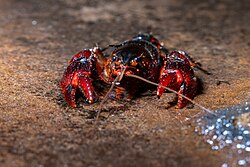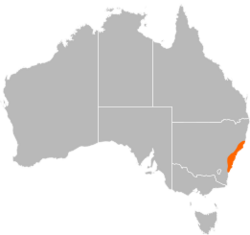Biology:Euastacus spinifer
| Euastacus spinifer | |
|---|---|

| |
| Scientific classification | |
| Domain: | Eukaryota |
| Kingdom: | Animalia |
| Phylum: | Arthropoda |
| Class: | Malacostraca |
| Order: | Decapoda |
| Suborder: | Pleocyemata |
| Family: | Parastacidae |
| Genus: | Euastacus |
| Species: | E. spinifer
|
| Binomial name | |
| Euastacus spinifer (Heller, 1865)
| |

| |
| Range of Euastacus spinifer (orange) in Australia | |
Euastacus spinifer is a species of freshwater crayfish endemic to Australia that belongs to the family Parastacidae.
Appearance
Morphological variation is observed in Euastacus spinifer that originate in different river systems. They are mostly green with reddish-brown joints and bright spines.[2]
Diet
Detritus forms the staple diet of the species but they may also eat small invertebrates and tadpoles.[2] They are also cannibalistic. They are also believed to be opportunistic omnivore.[3]
Life cycle
Mating takes place in winter when temperature drops to as low as 15 °C (59 °F), and eggs are laid in early July. Eggs are carried in the female Pleopods and hatch after an incubation period of 110–140 days. Hatch-lings stay with their parents until early summer. Males mature in 5–6 years and grow to 11 centimetres (4 in) on maturity while females take about 8 years and from above 14 centimetres (6 in). There are a class of "precious males" that mature at 4 centimetres (2 in) length. There are slight variation in reproduction cycle between species in different river systems.[4]
Size
Euastacus spinifer may grow up to 24 centimetres (9 in).[2] Largest recorded weight is 1.8 kilograms (4.0 lb).[5]
Distribution
They are endemic to Australia. They may be found from near sea level to as high as 1,200 metres (3,900 ft). They are distributed over a range of 55,000 square kilometres (21,000 sq mi).[1]
Habitat
Creeks and estuaries are their usual habitats. Their habitats are usually shaded by vegetation.[6]
Moulting
Moulting frequency of individuals in the species differ with size smaller individuals moult up to six times a year while larger individuals moult only once. Different sizes moult a different seasons temperature is believed to be the regulating force.[7]
References
- ↑ 1.0 1.1 Coughran, J.; Furse, J. (2010). "Euastacus spinifer". IUCN Red List of Threatened Species 2010: e.T153707A4534826. doi:10.2305/IUCN.UK.2010-3.RLTS.T153707A4534826.en. https://www.iucnredlist.org/species/153707/4534826. Retrieved 20 November 2021.
- ↑ 2.0 2.1 2.2 "Species Bank Treatment for Euastacus spinifer". https://m.ala.org.au/repo/1000/25/253561/raw.html.
- ↑ Diet and feeding in the freshwater crayfish, Euastacus spinifer (Decapoda: Parastacidae), from the Sydney region, AustraliaBy: Turvey, P ;Merrick, J R
- ↑ Reproductive biology of the freshwater crayfish, Euastacus spinifer (Decapoda: Parastacidae), from the Sydney region, Australia By Turvey Merrick, J R
- ↑ Growth with age in the freshwater crayfish, Euastacus spinifer (Decapoda: Parastacidae), from the Sydney region, Australia By: Turvey, P ;Merrick, J R
- ↑ "Euastacus spinifer Heller 1865". Tree of Life Web Project. http://tolweb.org/Euastacus_spinifer/7937. Retrieved 8 July 2013.
- ↑ Moult increments and frequency in the freshwater crayfish, Euastacus spinifer (Decapoda: Parastacidae), from the Sydney region, Australia By: Turvey, P ;Merrick, J R
External links
Wikidata ☰ Q1372077 entry
 |


